Key takeaways:
- Gender equality advocacy thrives on personal stories and shared experiences that foster collective movements.
- Strategic partnerships enhance advocacy efforts by pooling resources, insights, and data, bridging grassroots movements and policymakers.
- Clear communication, alignment of goals, and celebrating small victories are pivotal for effective collaboration and sustaining motivation among partners.
- Success stories serve to inspire others, reinforce the importance of advocacy work, and create a sense of community among stakeholders.

Understanding gender equality advocacy
Understanding gender equality advocacy is essential for driving societal change. I remember the first time I attended a gender equality workshop; I was struck by the passion in the room. It made me realize how vital it is to create spaces where everyone can share their experiences and insights. Without those personal stories, advocacy feels hollow.
At its core, gender equality advocacy is about ensuring that everyone, regardless of their gender, has equal rights and opportunities. Have you ever considered how different our world would be if we all collaborated more effectively? In my experience, forming partnerships can amplify our voices, turning individual stories into collective movements that challenge systemic barriers.
I often think about the transformative power of advocacy when I reflect on a successful campaign I was part of. What began as a small initiative grew into a larger coalition that brought together diverse perspectives. It was a powerful reminder that our combined efforts can lead to meaningful policy changes that benefit everyone involved.
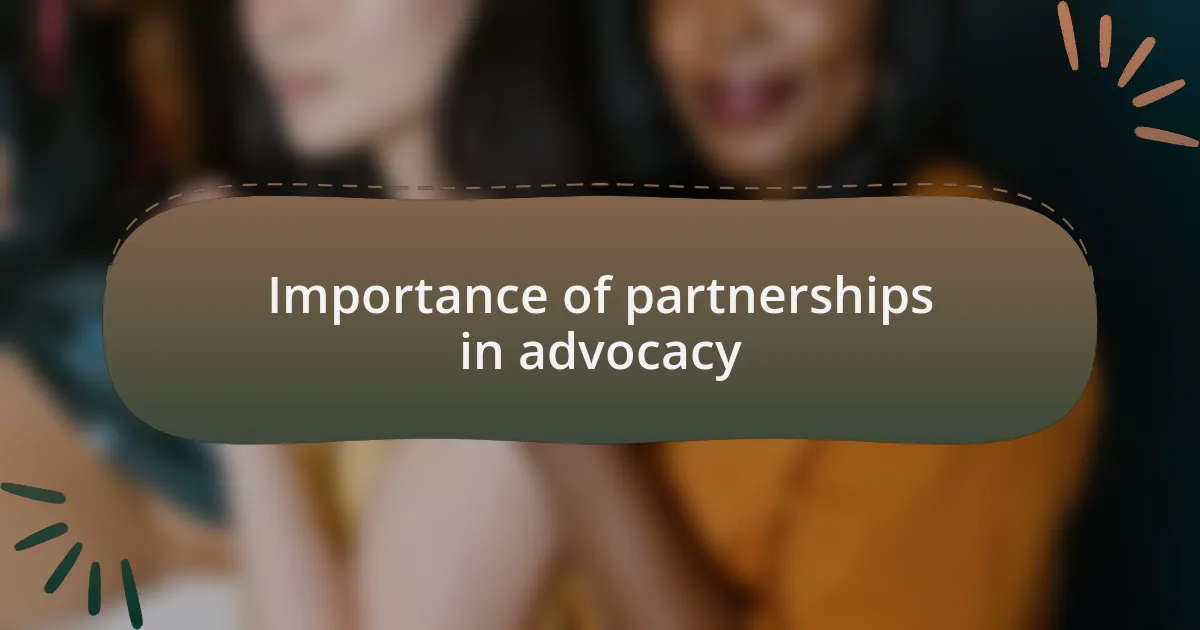
Importance of partnerships in advocacy
Building partnerships in advocacy is essential; it creates a network of support that can drive significant change. I recall a particular instance when my organization teamed up with local businesses to address gender-based violence. The campaign not only broadened our reach but also infused new energy into our message, showing me firsthand the impact collaboration can have.
Through partnerships, advocates can share resources and insights that enhance their efforts. I was once part of a coalition that pooled knowledge from various sectors, from education to healthcare. This collaboration helped us craft a comprehensive approach to policy change, demonstrating that when diverse voices unite, the results can be transformative and far-reaching.
Moreover, partnerships can help bridge gaps between grassroots movements and policymakers. I learned this during a campaign where we partnered with a local university to conduct research that informed our proposals. Engaging with academia not only lent credibility to our efforts but also highlighted the importance of data in advocating for policy changes. Have you pondered how much stronger our advocacy could be if we continually sought these strategic alliances?
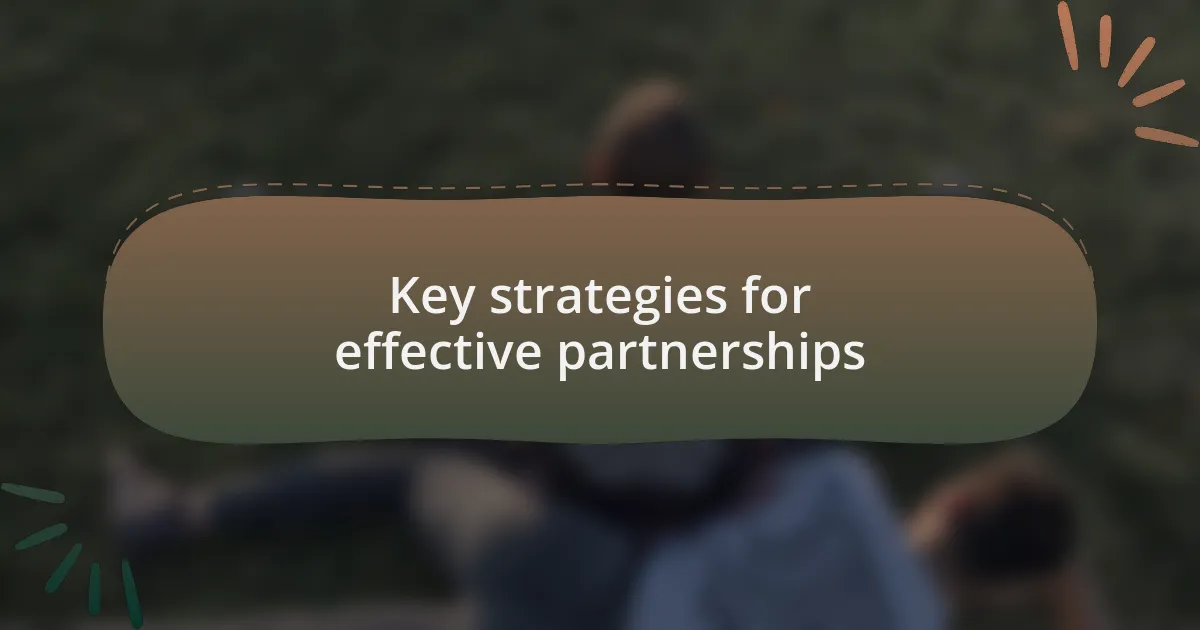
Key strategies for effective partnerships
Building effective partnerships often hinges on clear communication and shared goals. I remember a project where my team worked with a nonprofit focused on women’s rights. We spent weeks discussing our visions, ensuring every voice was heard. This clarity not only aligned our objectives but also fostered a sense of trust that made collaboration smoother and more impactful. Have you ever noticed how open dialogue can ease tensions and create a more cooperative atmosphere?
Setting boundaries and managing expectations is another crucial strategy. I’ve been in situations where misunderstandings about roles led to friction. When we established clear expectations upfront, it was like a weight lifted. Everyone felt more secure in their contributions, which led to a more harmonious working environment. How often do we forget that clarity can prevent conflict?
Lastly, celebrating small wins together strengthens partnerships. During a recent initiative, my team and I took time to acknowledge every milestone with our partners, no matter how minor. This practice not only boosted morale but also cultivated a shared sense of accomplishment. Have you tried celebrating victories with your collaborators? It can make all the difference in sustaining motivation and commitment.
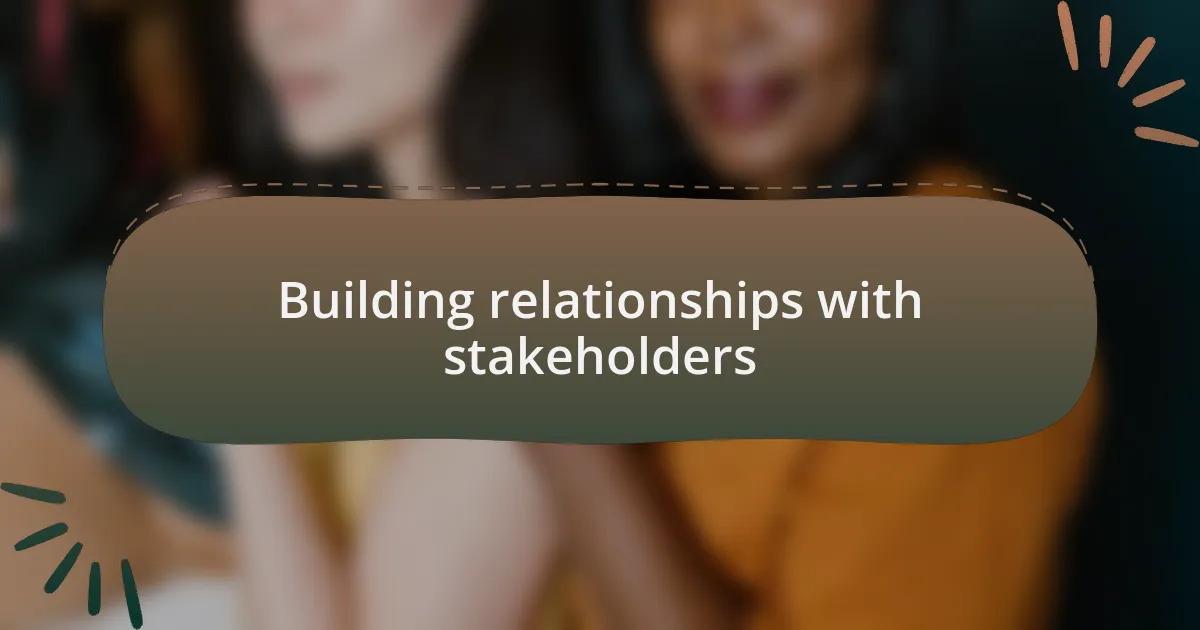
Building relationships with stakeholders
Building relationships with stakeholders is crucial, and I can recall a time when persistence played a key role. When I first approached a local business for support on a gender equality initiative, it felt daunting. Rather than expecting immediate buy-in, I took the time to understand their concerns and motivations. By fostering this open line of communication, I was able to create a partnership that was mutually beneficial, showing me the power of patience and empathy. Have you ever noticed how meaningful relationships often take time to develop?
Another lesson I learned was the importance of shared experiences. During a workshop, I encouraged stakeholders to share their personal journeys related to gender equality. This exercise not only humanized our discussions but also built a genuine connection between us. I was amazed at how individuals, initially hesitant, began to open up and recognize common goals. Isn’t it fascinating how personal stories can bridge gaps in understanding?
I’ve found that being transparent about challenges strengthens stakeholder relationships. For instance, when my team faced unexpected obstacles during a campaign, I decided to share these setbacks with our partners. Instead of shying away from the difficulties, I invited their input and support. This honesty fostered resilience within our group, reminding me that vulnerability can be a powerful tool in partnership building. Have you ever shared a challenge, only to find that it drew people closer together?
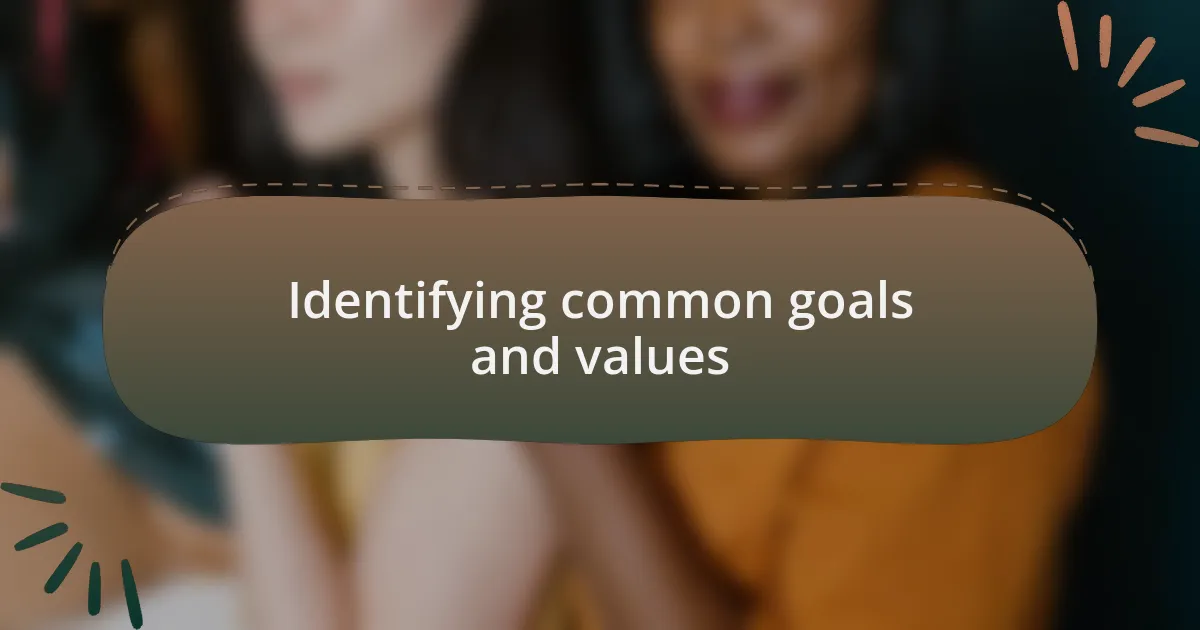
Identifying common goals and values
To effectively foster partnerships for policy change, it’s essential to identify common goals and values among stakeholders. I remember a specific dialogue with a community leader who was initially skeptical about collaborating. As we discussed the pressing issues of gender inequality, I discovered that we both shared a profound commitment to fostering inclusive environments. This realization shifted our conversation from hesitation to excitement, illustrating the significance of uncovering shared objectives. Isn’t it intriguing how quickly barriers can dissolve when common ground is established?
Finding common values often requires digging deeper than surface-level agreements. I once facilitated a discussion among diverse stakeholders, ranging from educators to business owners. During this meeting, we explored our individual motivations and discovered that, beyond gender equality, we all valued empowerment and social justice. It was a transformative moment, as our collective passions laid a strong foundation for collaboration. Have you explored what truly drives your partners in advocacy?
Additionally, aligning goals can sometimes mean reassessing your own priorities. I recall a time when a potential collaborator had a different approach to achieving gender equality—a more community-driven model than my more structured strategy. Instead of dismissing this perspective, I engaged in open dialogue and realized we could create a hybrid approach that harnessed both our methodologies. This experience taught me that flexibility in understanding goals can lead to innovative solutions that resonate with all parties involved. What have you discovered about aligning your vision with those of others?
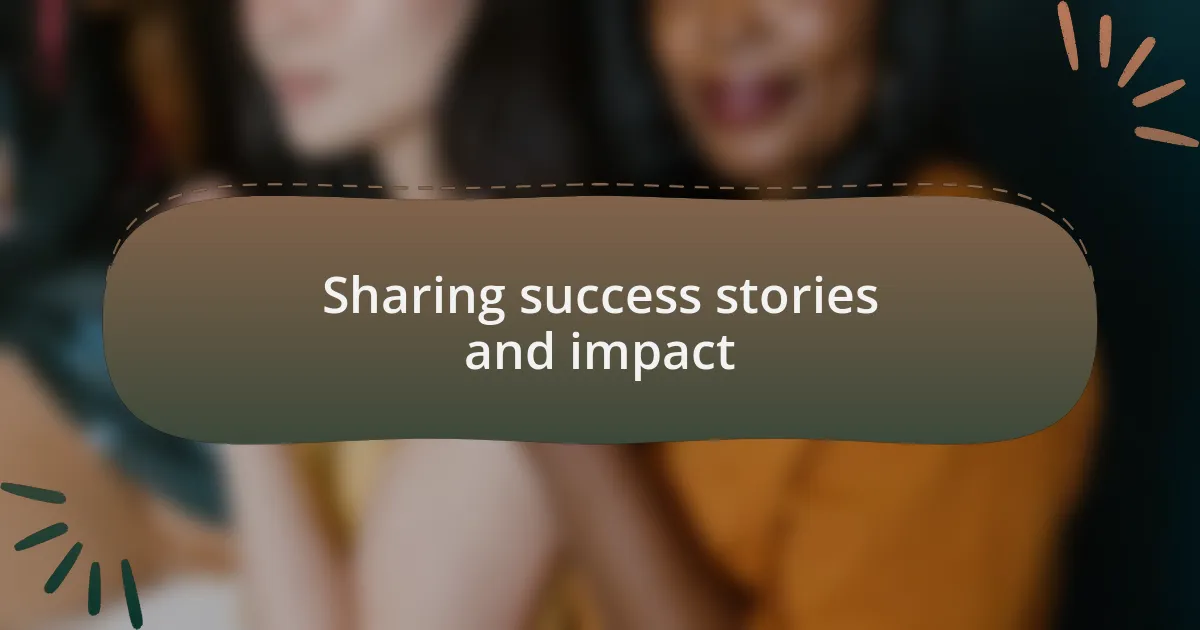
Sharing success stories and impact
Success stories play a crucial role in showcasing the tangible impacts of our advocacy efforts. I recall attending a conference where a colleague shared a powerful narrative about a grassroots initiative that transformed the lives of countless women in her community. The audience was captivated as she described not just the statistics, but the personal stories of triumph that brought the numbers to life. Isn’t it fascinating how a single success story can ignite passion in others and encourage them to advocate for change?
Beyond inspiring others, sharing these stories reinforces the importance of our work. I learned this firsthand when I presented our partnership’s achievements at a local town hall meeting. As I highlighted specific outcomes, such as increased access to education for girls, I saw nods of agreement and even heard murmurs of support. It struck me that when we articulate our impact clearly, we empower others to join our cause. Have you considered how your own successes can serve as a catalyst for broader change?
Lastly, documenting and sharing successes fosters a sense of community and commitment among partners. I remember compiling a report detailing our collaborative efforts and their outcomes to distribute among stakeholders. The collective pride in what we had achieved together solidified our commitment to ongoing work. It made me realize that celebrating these milestones isn’t just about looking back; it reinforces our shared journey and motivates us to keep pushing forward. How do you celebrate and communicate your advocacy victories?
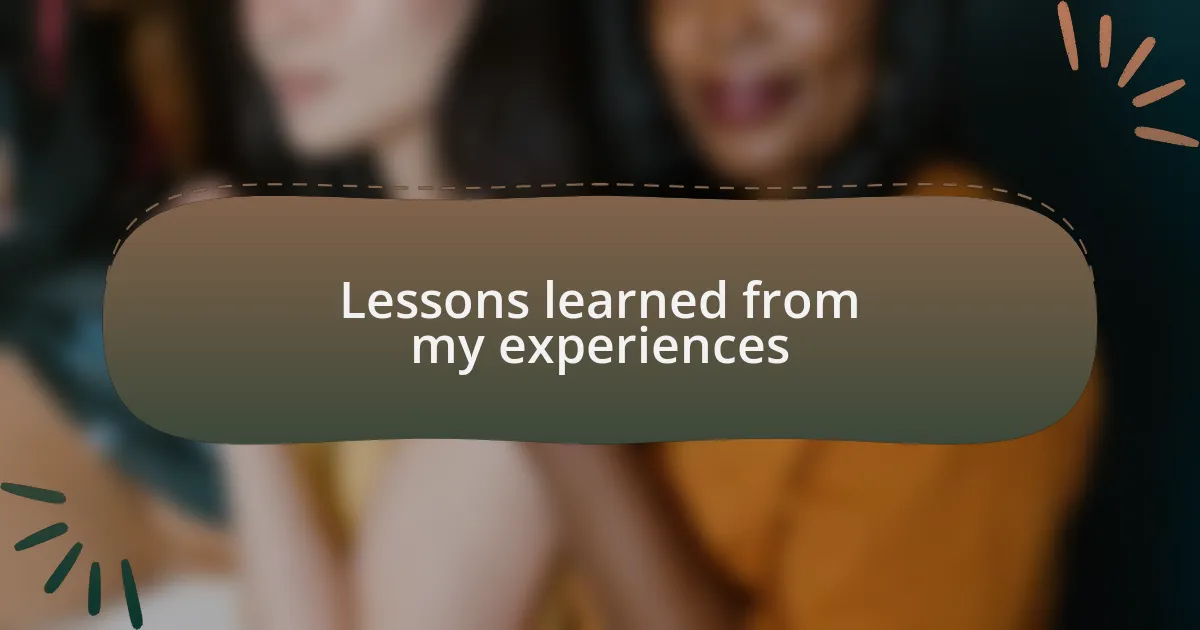
Lessons learned from my experiences
Throughout my journey in advocating for gender equality, I learned the importance of cultivating relationships built on mutual trust. I recall a challenging negotiation with a potential partner who initially viewed our objectives as too ambitious. By actively listening to their concerns and sharing my own motivations, I was able to bridge the gap and ultimately secure their collaboration. This experience taught me that openness and understanding can transform skepticism into partnership. Have you found that trusting relationships can shift perspectives in your work?
Another critical lesson I’ve internalized stems from the necessity of adaptability. I remember when a planned workshop fell through due to unforeseen circumstances. Instead of panicking, my team and I quickly pivoted to an online format, reaching a wider audience than anticipated. This taught me that flexibility not only ensures continuity but also opens doors to innovative solutions. Have you ever discovered unexpected opportunities in the face of a setback?
Lastly, I realized that celebrating small victories is as essential as striving for larger goals. During one of our monthly meetings, I proposed we take a moment to acknowledge the achievements of team members, no matter how small. The uplifted spirits and renewed energy were palpable. This moment highlighted that each step, no matter how minor, contributes to the overall journey toward policy change. How do you recognize and celebrate progress within your own advocacy efforts?